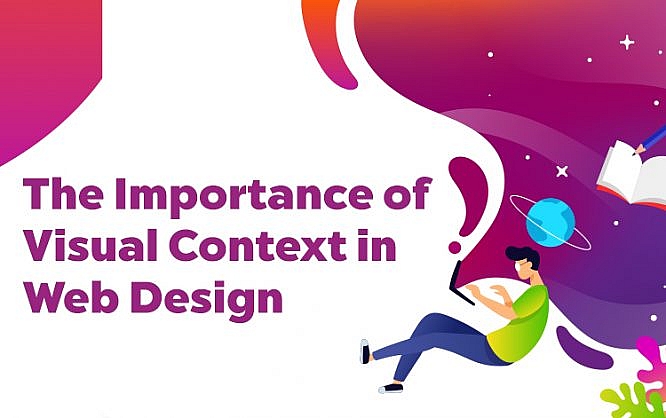The Importance of Visual Context in Web Design

In the early days of the internet, it was all about the text. There were not so many options and technology wasn’t as advanced to support crazy designs.
But as the world wide web progressed, so did the web design options. The focus slowly shifted towards the visual side. Besides informing the users, the designers aim to entertain, engage, and wow them with creative ideas.
People are visual beings, which means that visuals help them to have a better understanding of the message that your website wants to convey. If you want to make an impact on the users, improve user experience, and keep them longer on the website, adding visuals is the way to go.
While visuals are a necessary element for rounding up your web design, what about visual context?
What is Visual Context?
Visual context helps the design to convey the message.
Website owners want to deliver specific information through their website design. For example, an interior design company aims to show their expertise in their field. This is when visual context steps in. By using images that show their previous design projects within the web design, they can show the website visitors their vision.
Just think about it. If you need an interior designer would you rather give a chance to one that has images of beautiful designs or to one that just has plain text?
Visual context simply supports the claims on the website and helps the website visitor to instantly know what the website is about.
Why Should You Use Visual Context?
Visually pleasing websites always perform better. They grab and retain uses attention, unlike blocks of text which are more likely to drive them away.
Some types of visual context that you can use:
- Images (explaining the web site's purpose, presenting the business, supporting topics)
- Infographics (presenting the most important information)
- Lines, arrows, patterns, highlighted numbers (showing and simplifying directions)
- Icons (navigating the users through the website)
It doesn't matter whether the website is for a blogger or an e-commerce business owner, visuals should be welcome to the website.
When it comes to power which visual context has, here are some of the benefits you'll get if you use visual context in your web design.
1. Improve the First Impression
The first impression matters. That is a fact. Especially in the competitive internet world, where so many websites are battling for the users’ attraction.
It only takes 50 milliseconds for people to form a first impression. So, if a user comes across the website and finds the design dull, it is very likely that he or she will exit the page without much thought. Eliminate that risk by adding visuals.
Visuals will make the website more attractive and get the users to check out the website. There is just something about images and visuals that keeps our attention and makes us want to know more.
2. Give Users Better Explanations
Whenever a website features some sort of instructions or tutorials or even just a simple explanation, visual context can be a great addition to it.
People follow visual instructions 323% better than written instructions. Therefore, the visual context will enhance user experience and enable users to understand the instructions more easily.
Offer them information in a manner that will make it more understandable. The users will be more daring to explore the website when they can grasp the information without much trouble.
3. Make the Website Memorable
According to some studies, people will remember 65% of the visual content that they saw, even if they are asked about it almost three days after. On the other hand, they can recall only about 10% of the written content that they read, three days later.
“Whether you use images or videos, adding visuals will help the users to remember your website. The visuals act like a stamp which makes a lasting impression in people’s minds,” says Miriam Pierson, a web designer at Subjecto.
For example, you can use visuals to tell a story. Through storytelling, you'll be able to make the website’s content more convincing and effective.
4. Get Inspired by the Visuals
Visual context needs to be seamlessly integrated with the text.
While your content strategy probably starts with the idea to write the text and then add visuals, you can also take a different approach. If you find an inspiring image you can easily write the text that will complement it.
Another option is to find or create a video that rounds up your web design idea and then write the content that will support it.
5. Make It More Interesting
Sometimes you have no other choice but to deliver lots of written text, information, and stats. However, you do have a choice to add visual context to it and thus make it more interesting for users.
For example, when you are delivering stats about the company, you can create an infographic to present the information. Consider that 41.5% of marketers claim that original graphics, such as infographics, perform best, this is a perfect way of presenting content.
Not only can visuals make the content more interesting but it can also evoke emotions in users. Consequently, you’ll be able to create a relationship with them and turn them into loyal users or customers.
Some Final Thoughts
Visual context can bring your website to life. Without them, the website wouldn’t be as appealing, effective, and important as they are now. Use visual context to highlight the important message, to make it more fun for users, and to build trust in them. You’ll be surprised how powerful and impactful visuals can be. Choose the visual context carefully because otherwise, it can just confuse the users.
Images by Freepik.com

Thanks for your post